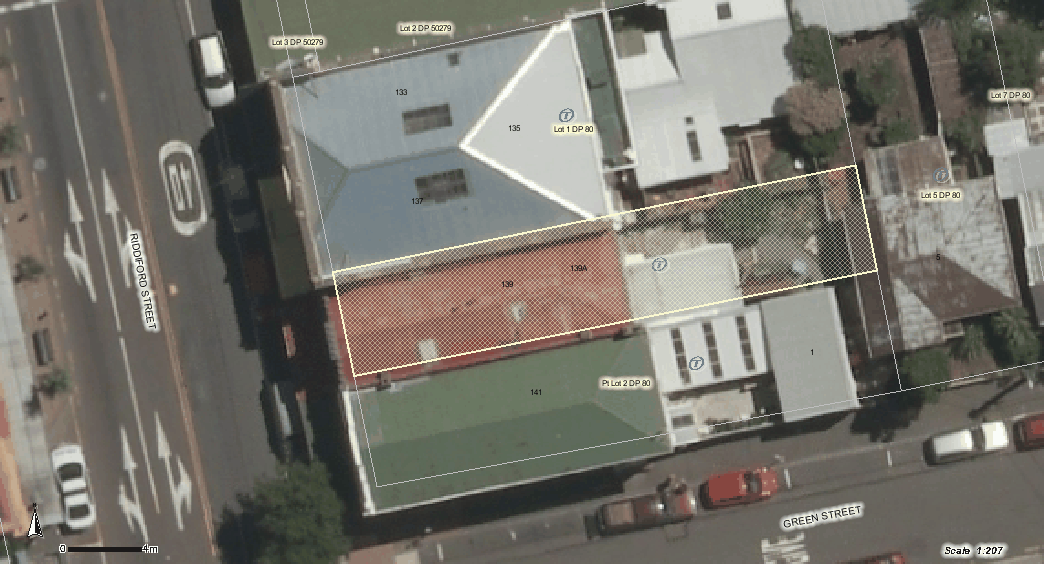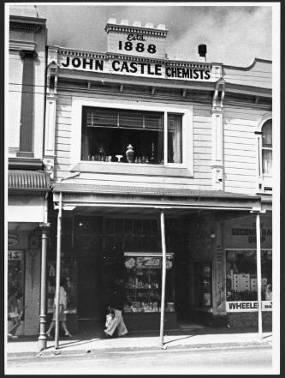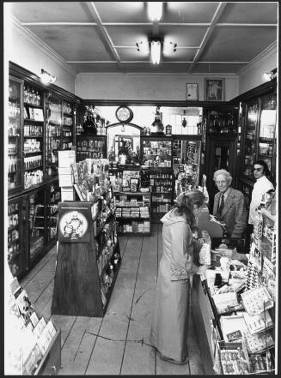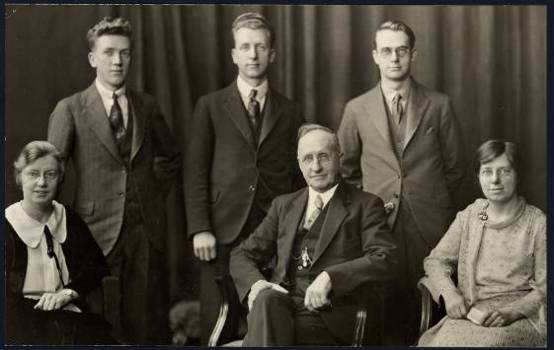Castles The Chemist



National Library reference: Short, Jack, fl 1977. John Castle's chemist shop, 139 Riddiford Street, Newtown, Wellington - Photograph taken by Jack Short. Dominion post (Newspaper) :Photographic negatives and prints of the Evening Post and Dominion newspapers. Ref: EP-Industry-Medicines and pharmaceutical-01. Alexander Turnbull Library, Wellington, New Zealand. http://natlib.govt.nz/records/23192267

National Library reference: Short, Jack, fl 1977. John Castle's chemist shop, 139 Riddiford Street, Newtown, Wellington - Photograph taken by Jack Short. Dominion post (Newspaper) :Photographic negatives and prints of the Evening Post and Dominion newspapers. Ref: EP-Industry-Medicines and pharmaceutical-02. Alexander Turnbull Library, Wellington, New Zealand. http://natlib.govt.nz/records/22811079

1929 - Members of the Castle family, from Newtown, Wellington. Left to right, back: Ronald, Raymond and Mervyn. Front: Mona, John Castle senior and Mavis.
National Library reference: Castle family - Photograph taken by Stanley Polkinghorne Andrew. New Zealand Free Lance : Photographic prints and negatives. Ref: PAColl-8983-28. Alexander Turnbull Library, Wellington, New Zealand. http://natlib.govt.nz/records/22818771
-
Constructed
1898
-
Heritage Area
-
Architect(s)
-
Builder(s)
Hawthorn and Crump
-
Good example of a two-storey Victorian shop and home. It’s notable for its classical proportions and ornamentation, particularly the mock ‘crenellations’ that are a visual pun on the name Castle.
This Newtown landmark has been a chemist since 1898. Five of the Castles’ seven children were pharmacists and each had their own pharmacy.
-
Downloadable(s)
-
close
History
-
Newtown was originally surveyed by the New Zealand Company in 1840 as part of the new settlement of Wellington. Newtown was farmland for its first few decades and only lightly settled. The relocation of Wellington Hospital and the extension of the tram system to the suburb in the 1880s spurred subdivision. Within 40 years, the suburb was effectively filled.
The Newtown Central suburban centre has a largely uninterrupted streetscape of Victorian and Edwardian buildings. Most of the buildings are two storey and timber and date form the period of the suburb’s early development. Almost all are the first buildings to occupy their sites. The suburb’s early self sufficiency was epitomised by the range of shops, specialised or otherwise, that lined Riddiford Street. Many shops had the same occupants for decades. The second half of the century saw much change, with the end of the trams in 1964, the closing of many long-standing shops, families moving out to suburbs further afield, and the influx of immigrants.
Built in 1898, 139 Riddiford Street was occupied by descendants of the original business owners, the Castle family. Both the building and business have survived largely intact in that time and there are few institutions in the city that can claim such longevity. Castle’s The Chemist is a Newtown landmark.
It is not from known where John Castle operated his first retail outlet but in 1898 he built new premises in Riddiford Street. This would seem to have been a combined development, for the original permit described the new building as shops for Messrs Wylie and Castle. The architect is not known but the plans suggest that it was designed by the builders, Hawthorne and Crump. The flat above the Castle shop was used as a family home by the Castle family and was later a doctor’s surgery.
John and Annie Castle had seven children and, remarkably, five of them (three sons and two daughters) qualified in pharmacy. They each set up separate Castle’s chemist shops until there were five in operation in Wellington; as each retired, the shops were sold and eventually only the Newtown shop remained. It was run in later years by youngest son Ronald, who kept the appearance of the shop much as it would have been in his father’s day. Material returned from the other Castle shops eventually ended up in a museum on the first floor. The family was also well known for its collection of antique musical instruments.
Ronald Castle retired in 1981. Although the contents of the museum were sold to the pharmaceutical Association in 1984 when Ronald died, the shop retains some of its late Victorian ambience, as well as its original function as a chemist.
-
Modifications
close
-
1898
-
Consent granted to Hawthorn and Crump for a semi-detached shops and dwellings plus a shed
-
1928
-
Alterations made to the shop
-
1981
-
Alterations to the shop front; included a new shop window designed by Craig Moller
-
1985
-
Building partly re-piled
-
1986
-
Alterations made to the flat and shop
-
1990
-
Alterations and additions to the office building
-
2012
-
Building consent granted to install a steel portal frame to span across shop front at ground floor to first floor level as part of earthquake strengthening.
-
-
Occupation History
close
Not assessed
-
Newtown was originally surveyed by the New Zealand Company in 1840 as part of the new settlement of Wellington. Newtown was farmland for its first few decades and only lightly settled. The relocation of Wellington Hospital and the extension of the tram system to the suburb in the 1880s spurred subdivision. Within 40 years, the suburb was effectively filled.
-
close
Architectural Information
-
Building Classification(s)
close
Not assessed
-
Architecture
close
It is a modest two-storey timber building designed in a simple but forthright late-Victorian commercial style, with a hipped roof concealed behind the high parapet. Below the verandah is an awkward modern shop-front that partly masks an interesting interior – this still has many of the original display cabinets and shelves.
The verandah has some old fabric visible, including a section of pressed metal tiles in the soffit, and it appears to be on the original line, although the posts are modern steel ones. Above the verandah, the upper façade is in quite authentic condition. It has a central array of four double-hung windows in a weatherboarded wall (the sash windows are a sensitive, modern alteration that date from post-1981); the two brick party walls on either side of the building are projected out from the wall face and are ornamented with panelled pilasters at either side of the façade and further decorated with elaborate bosses at the cornice line. The large moulded timber cornice separates the upper wall from the parapet, which has an elevated central pediment and is particularly distinctive for its quirky mock crenulations, referring back to the name of the business.
-
Materials
close
Timber and brick construction
Double hung sash windows
Weatherboards
Pressed metal tiles to underside of verandah
-
Setting
close
Castle’s The Chemist is one of a number of early buildings of modest scale that define the character of the central commercial part of Riddiford Street.
Castle’s plays a role in establishing townscape qualities in Newtown, its well-known name and longevity in the street adding to its physical qualities.
Heritage Area
This building contributes to the Newtown Central Shopping Centre Heritage Area. A detailed outline of the heritage area can be found in the Wellington City Council report “Newtown Central Shopping Centre Heritage Area: Riddiford Street, Constable Street, Rintoul Street”, 28 October 2008.
This building became part of the heritage area in District Plan Change 75.
-
Building Classification(s)
close
-
close
Cultural Value
Castle’s Chemist shop is a good representative example of a two storey Victorian shop/residence. It is notable for its Classical proportions and ornamentation, particularly the mock ‘crenulations’ that are a visual pun on the name Castle.
This building contributes to the Newtown Central Shopping Centre Heritage Area.
Due to the building’s long association with the Castle Family and continuance as a chemist since 1898, it is a Newtown landmark and held in high regard.
Castle’s is one of a number of early buildings of modest scale that define the character of the central commercial part of Riddiford Street.
-
Aesthetic Value
close
-
Architectural
Does the item have architectural or artistic value for characteristics that may include its design, style, era, form, scale, materials, colour, texture, patina of age, quality of space, craftsmanship, smells, and sounds?
Castle’s Chemist shop is a good representative example of a two storey Victorian shop/residence. It is notable for its Classical proportions and ornamentation, particularly the mock ‘crenulations’ that are a visual pun on the name Castle.
-
Group
Is the item part of a group of buildings, structures, or sites that taken together have coherence because of their age, history, style, scale, materials, or use?
The building has group value as one of a number of early buildings of modest scale that define the character of the central commercial part of Riddiford Street. Most of the buildings, like this one, are two storey and timber built and date from the period of the suburb’s early development.
-
Townscape
Does the item have townscape value for the part it plays in defining a space or street; providing visual interest; its role as a landmark; or the contribution it makes to the character and sense of place of Wellington?
The building contributes to the Newtown Central Suburban Centre Heritage Area, a precinct that has a largely uninterrupted streetscape of Victorian and Edwardian buildings. The building is a local landmark for its association with the long-established business ‘Castles the Chemist’ and for its unusual ‘crenulated’ parapet.
-
-
Historic Value
close
-
Association
Is the item associated with an important person, group, or organisation?
Both the building and business have survived largely intact for over 110 years and there are few institutions in the city that can claim such longevity. The association of the Castle family with both the shop and their pharmaceutical collection, and the old world ambience of the building’s interior, have made it well known in Wellington.
-
-
Scientific Value
close
-
Archaeological
Does the item have archaeological value for its ability to provide scientific information about past human activity?
There was pre-1900 human activity on this site. Although some of the sites have been altered by rebuilding or landscaping or subdivisional change, there is archaeological value in the immediate surrounds.
-
-
Social Value
close
-
Identity/Sense of place/Continuity
Is the item a focus of community, regional, or national identity? Does the item contribute to sense of place or continuity?
The building has been in continuous use as a pharmacy for over 110 years, during which time there have been few intrusive alterations to its external form (with the notable exception of the modern shopfront). The building contributes to the sense of place and continuity of the Newtown Central Suburban Centre Heritage Area.
-
Public Esteem
Is the item held in high public esteem?
Due to the building’s long association with the Castle Family and continuance in use as a chemist since 1898, it is a Newtown landmark and held in high regard
-
- Level of Cultural Heritage Significance close
-
Local / Regional / National / International Importance
close
Not assessed
-
Aesthetic Value
close
-
close
Site Detail
-
District Plan Number
6/ 260
-
Legal Description
PT LOT 2 DP 80
-
Heritage New Zealand Listed
Not listed
-
Archaeological Site
Pre 1900 building, Maori Site of Significance
-
Current Uses
unknown
-
Former Uses
unknown
-
Has building been funded
No
-
Funding Amount
Not applicable
-
Earthquake Prone Status
Not Earthquake Prone
-
-
close
Additional Information
-
Sources
close
- Wellington City Council, Wellington Heritage Building Inventory 2001: Non-Residential Buildings, Wellington City Council, 2001.
- Wellington City Council, Newtown Central Shopping Centre Heritage Area, Riddiford Street, Constable Street, Rintoul Street, Wellington City Council: unpublished report, October 2008.
- Technical Documentation close
-
Footnotes
close
Not available
-
Sources
close
Last updated: 5/23/2019 10:53:41 PM
